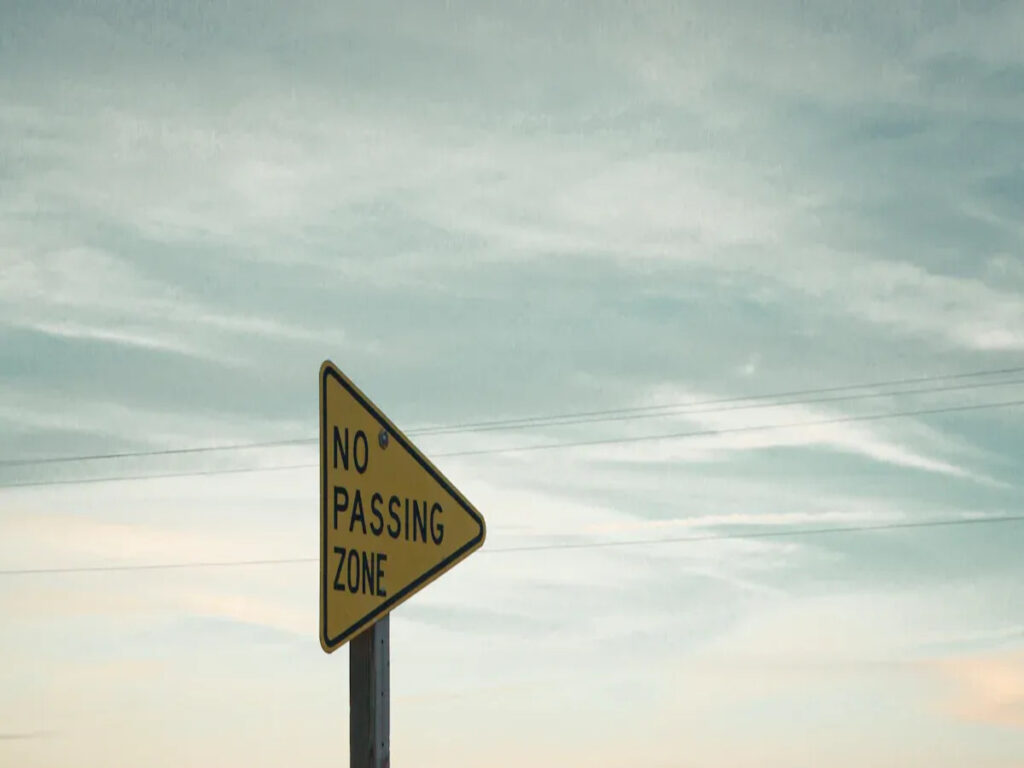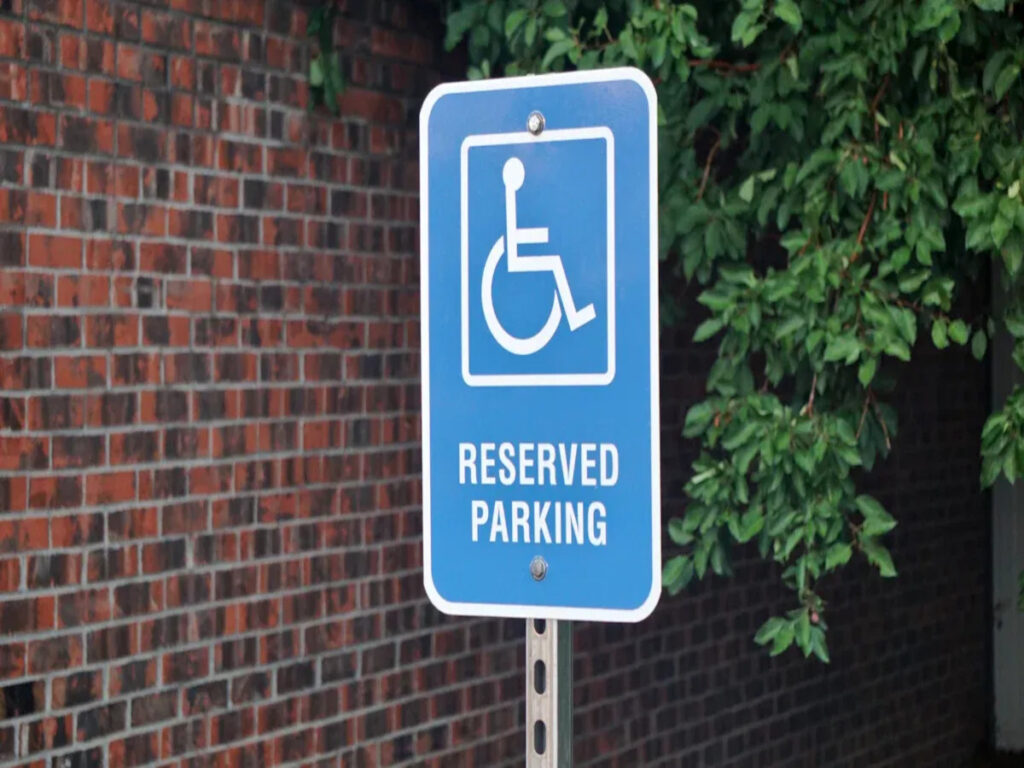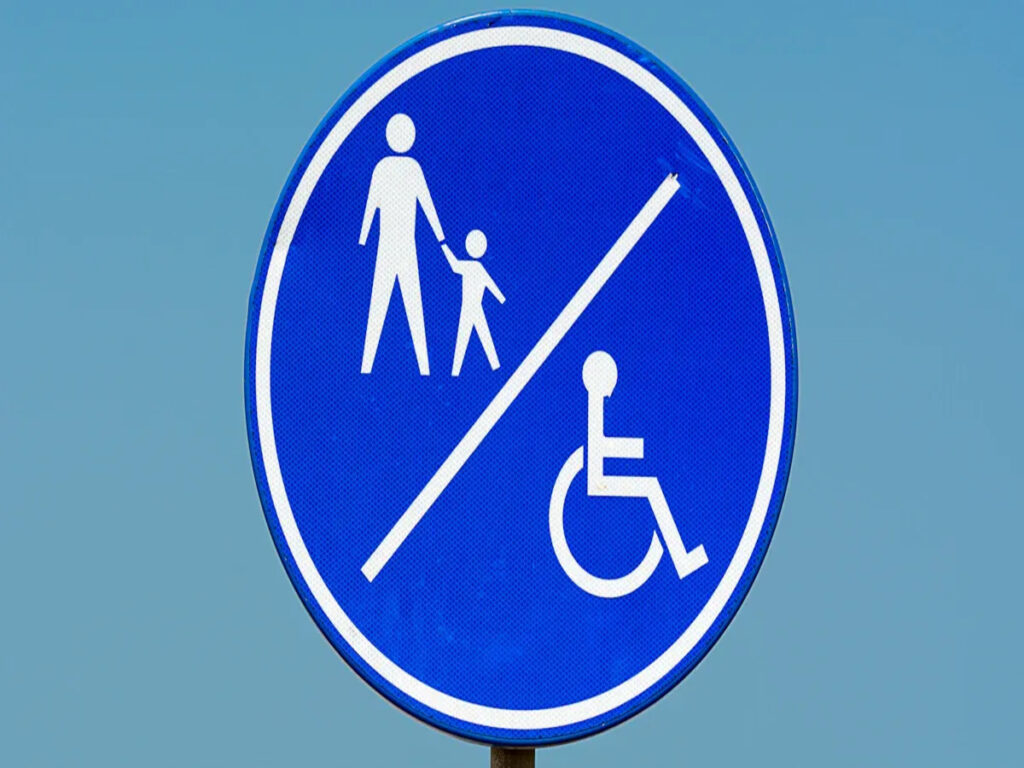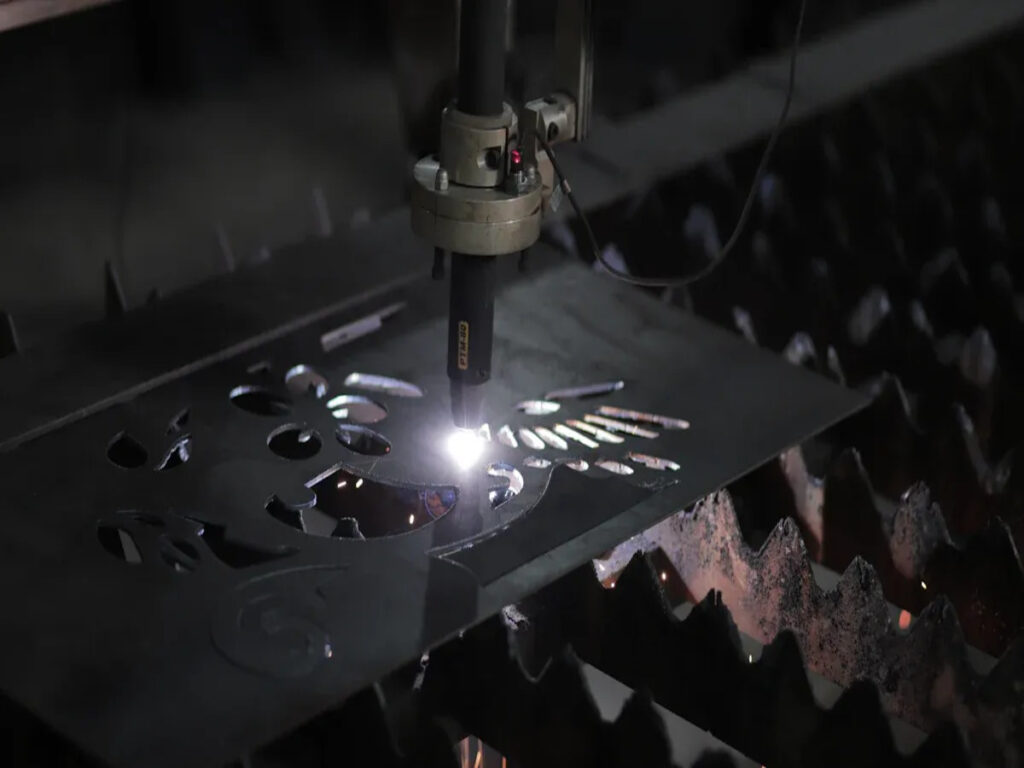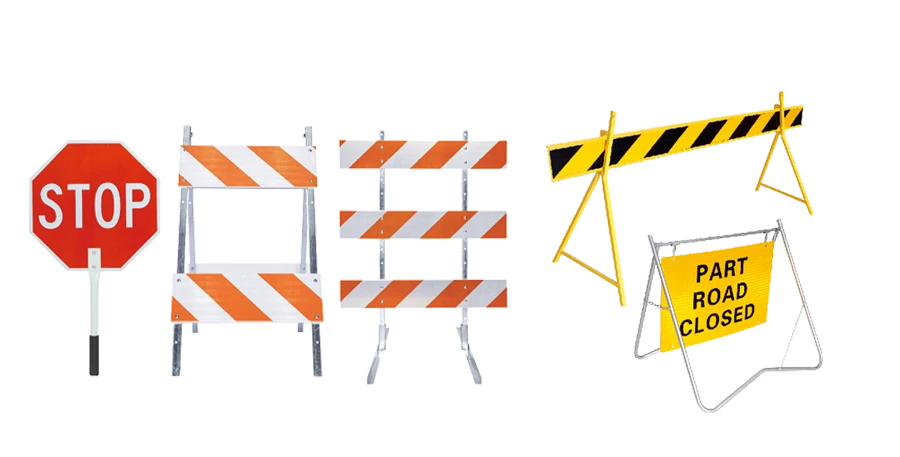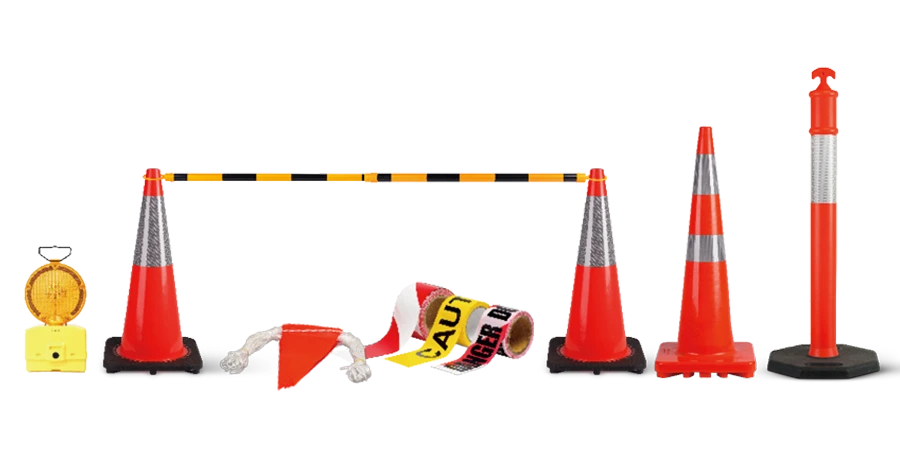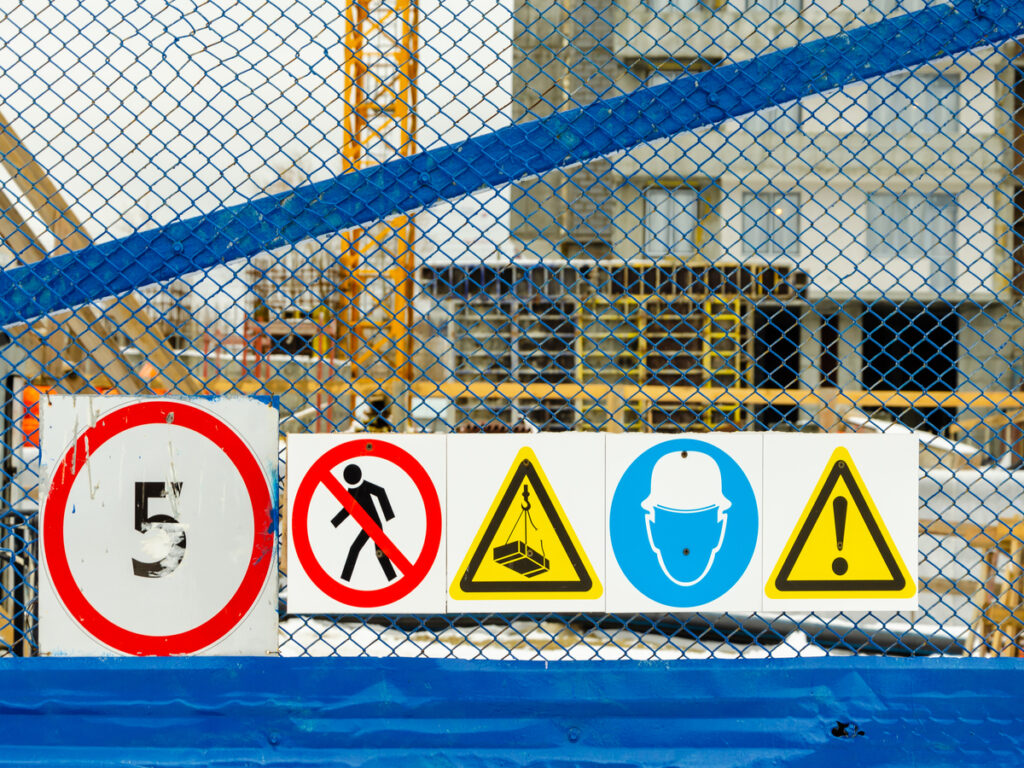
تخيل أن العامل يسيء تفسير علامة الخطر لأن الرمز أو اللون غير واضح. مثل هذا الخطأ يمكن أن يؤدي إلى عواقب وخيمة. ISO 7010 يساعد في منع هذه المخاطر من خلال توحيد الألوان والرموز المستخدمة في علامات السلامة في مكان العمل. هذا يضمن أن الجميع يفهم على الفور معنى العلامة. في البيئات التي يتم التحدث فيها بلغات متعددة, هذا النهج يقلل من الارتباك ويعزز السلامة العامة.
- ISO 7010 من السهل التعرف على الرموز, حتى لو كانت اللغة غير مألوفة.
- تتيح علامات السلامة المتسقة في مكان العمل استجابات أسرع خلال حالات الطوارئ.
الوجبات الرئيسية
- ISO 7010 يجعل ألوان علامة السلامة ورموزها هي نفسها في كل مكان. هذا يساعد الجميع على رؤية الأخطار في العمل بسهولة.
- إن استخدام نفس الأشكال والألوان يساعد العمال على اكتشاف المخاطر بسرعة. هذا يقلل من الحوادث ويساعد الناس على التصرف بسرعة في حالات الطوارئ.
- علامات بدون كلمات تعمل بشكل جيد حيث يتحدث الناس العديد من اللغات. هذا يساعد جميع العمال على البقاء آمنين, لا يهم من أين هم.
- غالبًا ما يجعل التحقق من علامات السلامة وتحديثها سهلة الرؤية والتصحيح. هذا يساعد على إيقاف الحوادث ويبقي الجميع آمنين.
- تعليم العمال حول ISO 7010 تساعدهم العلامات على معرفة السلامة. هذا يجعل مكان العمل أكثر أمانًا وجاهزة للمشاكل.
ISO 7010 وعلامات السلامة في مكان العمل
التقييس
ISO 7010 يعطي قواعد واضحة لعلامات السلامة في العمل. المعيار يخبرنا ما هي الأشكال, الألوان, والتصويرات التوضيحية لاستخدامها في كل رسالة أمان. هذا يعني أن كل رمز يعني دائمًا نفس الشيء. على سبيل المثال, إن مثلث أصفر مع حافة سوداء هو دائما تحذير. تُظهر الدائرة الزرقاء دائمًا شيئًا يجب عليك فعله. التصميمات بسيطة وتجعل من السهل على العمال معرفة معنى العلامة على الفور.
يساعد التقييس على التوقف عن الارتباك. تشير الدراسات. إذا استخدمت جميع أماكن العمل نفس العلامات, لا يتعين على العمال تعلم رموز جديدة عندما يغيرون الوظائف. هذا يجعل الأخطاء أقل احتمالا, خاصة في حالات الطوارئ عندما يكون الوقت مهمًا.
ملحوظة: إذا قمت بخلط قديم, تلاشى, أو علامات غير قياسية مع ISO 7010 علامات, يمكن للناس الخلط والرد أبطأ في حالات الطوارئ. باستخدام ISO فقط 7010 العلامات تساعد على إيقاف هذه المشاكل.
الوضوح والاتساق
الوضوح والاتساق مهمان للغاية في ISO 7010. المعيار يتأكد من أن كل علامة أمان تعطي رسالتها دون استخدام الكلمات. هذا يساعد الجميع على الفهم, حتى لو لم يتحدثوا نفس اللغة أو لا يمكنهم القراءة جيدًا. هذا مفيد للغاية في الأماكن التي يتحدث فيها الناس العديد من اللغات.
يساعد استخدام نفس الأشكال والألوان الأشخاص على معرفة نوع رسالة السلامة التي هي. على سبيل المثال, الدوائر الحمراء مع خط من خلالها تعني دائمًا أنه يجب ألا تفعل شيئًا. تظهر المستطيلات الخضراء أماكن آمنة أو مخارج الطوارئ. من هنا, يمكن للعمال التصرف بسرعة وبشكل صحيح, حتى لو شعروا بالتوتر.
العديد من البلدان تتبع ISO 7010 قواعد لجعل علامات السلامة هي نفسها في كل مكان. تضع هذه البلدان المعيار في قوانينها, لذا فإن الشركات تلبي قواعد السلامة المحلية والعالمية على حد سواء. يوضح الجدول أدناه كيف تستخدم بعض البلدان هذه المعايير:
| وجه | ISO 7010 (دولي) | سويسرا (sn iso 7010) | ألمانيا (من 4844) | الولايات المتحدة الأمريكية (Ansi Z535) |
|---|---|---|---|---|
| الإطار القانوني | إطار عمل عالمي لعلامات السلامة | التبني الكامل, الامتثال الإلزامي | متكامل في اللوائح الوطنية | المراجع OSHA ANSI Z535; يختلف الامتثال |
| معايير التصميم | صارم على الرموز, الألوان, الأشكال | التبني المباشر لـ ISO 7010 عناصر | محاذاة وثيقة, بعض التعديلات | رموز مماثلة, مزيد من المرونة |
| إنفاذ | يختلف عالميا | عمليات تفتيش منتظمة, عقوبات لعدم الامتثال | عمليات التدقيق والتفتيش من قبل الهيئات التنظيمية | عمليات التفتيش OSHA, يختلف التنفيذ |
| التدريب والتوعية | يؤكد تدريب التعرف على الرموز | برامج تدريب شاملة | التدريب على ISO 7010 والتكيفات | يتضمن التدريب الرموز والنص |
جعل علامات السلامة واضحة وتساعد نفس الشيء في كل مكان على بناء مكان عمل آمن. يعرف العمال العلامات, التصرف بشكل أسرع في حالات الطوارئ, وتظهر الشركات أنها تهتم بالسلامة واتباع القواعد.
معايير الألوان
أحمر, أصفر, أخضر, أزرق
ISO 7010 يستخدم ألوان معينة لكل علامة أمان. هذه الألوان تساعد العمال على معرفة معنى العلامة بسرعة. يسرد الجدول أدناه الألوان الرئيسية, ماذا يعني, وأشكالهم:
| نوع علامة | معنى | لون | شكل |
|---|---|---|---|
| علامة الحظر | يجب ألا تفعل | أحمر | دائرة مع خط قطري |
| علامة إلزامية | يجب أن تفعل | أزرق | دائرة |
| علامة تحذير | تحذير من الخطر | أصفر | مثلث متساوي الأضلاع مع زوايا مستديرة |
| علامة حالة آمنة | تحديد معدات السلامة والمخرج | أخضر | مربع أو مستطيل |
| علامة السلامة من الحرائق | تحديد معدات مكافحة الحرائق | أحمر | مربع |
الأحمر يعني وجود خطر أو شيء غير مسموح به. الأزرق يعني أنه يجب عليك فعل شيء ما. يحذر الأصفر من الأخطار المحتملة. العروض الخضراء أماكن آمنة, يخرج, أو نقاط الإسعافات الأولية. تستخدم علامات السلامة من الحرائق الأحمر أيضًا, لكن في شكل مربع, لإظهار أين توجد معدات الإطفاء.
ملحوظة: يتم اختيار هذه الألوان والأشكال عن قصد. ISO 7010 له قواعد صارمة ، لذا من السهل رؤيتها وفهمها العلامات, حتى من بعيد أو في الضوء السيئ.
التأثير النفسي
يتغير اللون كيف يتفاعل الناس مع علامات السلامة. تظهر الدراسات أن الدماغ يرى الألوان والرموز أسرع من الكلمات. هذا يساعد العمال على ملاحظة الخطر والعمل قبل قراءة أي نص.
- الأحمر يجعل الناس يشعرون بشيء عاجل أو خطير. يجعلهم يتوقفون وينظرون. غالبًا ما يتفاعل العمال بسرعة عندما يرون اللون الأحمر.
- الأصفر يجعل الناس أكثر تنبيهًا وذويًا. يحذر من الخطر ولكنه لا يجعل الناس يشعرون بالذعر. يولي العمال المزيد من الاهتمام في المناطق الصفراء.
- الأزرق يجعل الناس يشعرون بالهدوء والأمان. يساعدهم على اتباع التعليمات, مثل ارتداء معدات السلامة.
- الأخضر يعني السلامة ويجعل الناس يشعرون بتحسن. يساعد الناس في العثور على المخارج أو الإسعافات الأولية بسرعة في حالات الطوارئ.
أزواج الألوان الزاهية, مثل الأحمر والأصفر أو الأخضر والأبيض, جعل العلامات أسهل في الرؤية. هذه الأزواج تساعد علامات تبرز, حتى في الأماكن المزدحمة.
فيما يلي بعض الأمثلة الحقيقية لكيفية توقف ترميز الألوان عن حوادث:
- الخطوط الصفراء تميز الممرات ومسارات المرور, مساعدة العمال على التحرك بأمان.
- تحافظ الخطوط الحمراء والأبيض على المناطق أمام معدات النار أو الألواح الكهربائية واضحة, لذلك لا شيء يمنعهم في حالة الطوارئ.
- الخطوط الصفراء والأسود تظهر المخاطر, تذكير العمال بالتوخي الحذر.
- تساعد الخطوط الأصفر أو الأحمر الضوئي للأشخاص على العثور على المخارج إذا خرجت الأنوار.
هذه العلامات تساعد العمال على اكتشاف المخاطر والأماكن الآمنة على الفور. باستخدام نفس الألوان والأشكال, كما ISO 7010 يقول, يتوقف عن الارتباك ويساعد الناس على التصرف بشكل أسرع. هذا يجعل مكان العمل أكثر أمانًا للجميع, بغض النظر عن اللغة التي يتحدثونها أو من أين هم.
الرموز والأشكال
الرموز العالمية
ISO 7010 يستخدم الصور التوضيحية لمشاركة رسائل السلامة بدون كلمات. هذه الرموز تساعد الجميع على معرفة المخاطر, حتى لو لم يتمكنوا من قراءة اللغة أو التحدث بها. كل رسم تخطيطي له صورة بسيطة ولون مشرق لإظهار المخاطر أو ماذا تفعل. هذا يجعل الأمور أقل إرباكًا ويساعد العمال على التصرف بسرعة.
بعض ISO 7010 الصور التوضيحية التي قد تراه:
- W001: تحذير عام - علامة تعجب أسود في مثلث أصفر يحذر من الأخطار العامة.
- W012: خطر الكهرباء - يظهر صاعقة البرق الأسود أن هناك خطر من الكهرباء.
- W021: مادة قابلة للاشتعال - رمز اللهب يعني أن شيئًا ما يمكن أن يطلق النار بسهولة.
- W003: المواد المشعة - يحذر رمز Trefoil من مخاطر الإشعاع.
- W023: مادة تآكل - أنبوب اختبار يصب سائل على يد وسطح يعني أن المادة الكيميائية يمكن أن تحرق أو تلف الأشياء.
- W009: خطر بيولوجي - يحذر الرمز الحيوي من الجراثيم أو الفيروسات الخطرة.
- W011: سطح زلق - يظهر شخص ينزلق الأرضية رطبة أو زلقة.
ISO 7010 الرموز استخدم صورًا وألوانًا واضحة. هذا يساعد العمال الذين لا يستطيعون القراءة جيدًا أو التحدث باللغة. التصميم يبقي الجميع آمنين, لا يهم من أين هم.
أشكال للاعتراف السريع
الأشكال مهمة جدا في ISO 7010 علامات السلامة. كل نوع علامة له شكل ولون خاص به. هذا يجعل من السهل رؤية ومعرفة معنى العلامة. علامات التحذير هي مثلثات صفراء. علامات الحظر هي دوائر حمراء مع خط. العلامات الإلزامية هي دوائر زرقاء. علامات الحالة الآمنة هي مستطيلات أو مربعات خضراء. علامات السلامة من الحرائق هي مربعات حمراء.
| نوع علامة | شكل | لون | مثال رمز |
|---|---|---|---|
| تحذير | مثلث | أصفر | ⚡ (خطر الكهرباء) |
| حظر | دائرة مع الخط | أحمر | 🚭 (ممنوع التدخين) |
| إلزامي | دائرة | أزرق | 🦺 (ارتداء سترة السلامة) |
| حالة آمنة | مستطيل/مربع | أخضر | 🏥 (الإسعافات الأولية) |
| السلامة من الحرائق | مربع | أحمر | 🔥 (طفاية النار) |
هذا النظام يساعد الناس على معرفة رسالة السلامة على الفور, حتى عندما يشعرون بالتوتر. إن استخدام نفس الأشكال والألوان يساعد العمال على التصرف بسرعة في حالات الطوارئ. ISO 7010 تأكد من أن علامات السلامة تبدو متشابهة في كل مكان, حتى يتمكن الجميع من فهمهم بسهولة.
فوائد أماكن العمل
الحد من الحوادث
ISO 7010 يساعد أماكن العمل من خلال جعل الحوادث والإصابات أقل احتمالًا. عندما تبدو علامات السلامة متشابهة في كل مكان, اكتشف الناس المخاطر بشكل أسرع. لا يشعر العمال بالارتباك برموز أو ألوان غريبة. إنهم يعرفون ماذا يفعلون على الفور, لذلك يتخذون خيارات أكثر أمانًا.
هناك العديد من القصص الواقعية عن ISO 7010 علامات:
- تعرض شواطئ هاواي أقل إصابات وموت بعد استخدام علامات ISO. لقد فهم السياح من دول أخرى التحذيرات بشكل أفضل.
- رأى Willoughby Aquatics في أوهايو أ 55% إسقاط السحب في السباح بعد وضع علامات السلامة الجديدة.
- تغيرت الحدائق والجامعات في جنوب شرق الولايات المتحدة علامات النص فقط على رموز ISO. أرادوا إيقاف الحوادث وتجنب التعرض للمشاكل.
قطعت علامات السلامة الجيدة في المدارس حوادث ما يصل إلى ما يصل إلى 80%. علامات واضحة تساعد الناس في حالات الطوارئ وجعلها 40% أكثر جاهزة.
علامات الخروج الأخضر, أي iso 7010 يقول للاستخدام, من السهل رؤيتها في حالات الطوارئ. تشير الدراسات إلى أن الناس يجدون هذه العلامات أسرع من الألوان الأخرى. هذا يساعد الجميع على المغادرة بسرعة وأمان. علامات تتوهج في الظلام أو الاستخدام مصابيح LED يمكن رؤيته حتى لو خرجت الطاقة أو وجود دخان. هذا يساعد الناس على الهروب في حالة الطوارئ.
الامتثال والتدريب
إن استخدام نفس العلامات يجعل من السهل على أماكن العمل اتباع القانون والقيام بالشيء الصحيح. ISO 7010 تأكد من أن علامات السلامة تبدو دائمًا متشابهة وتعني نفس الشيء. هذا يساعد الشركات على اتباع القواعد في بلدها وحول العالم.
التدريب أفضل عندما يتعلم الجميع نفس العلامات. يمكن للعمال الجدد اكتشاف المخاطر والطرق الآمنة من يومهم الأول. غالبًا ما تستخدم دروس السلامة من الحرائق ISO 7010 علامات, لذلك يعرف الموظفون كيفية إيقاف الحرائق وماذا يفعل إذا بدأ المرء. تُظهر الشركات التي تستخدم هذه العلامات أنها تهتم بالسلامة والحصول على اسم أفضل.
باستخدام ISO 7010 علامات تساعد العمال الجدد على التعلم, يجعل الناس أكثر استعدادًا, ويبني مكان عمل حيث يهم السلامة أكثر.
تنفيذ ISO 7010
التقييم والتخطيط
تحتاج المنظمات إلى خطة واضحة لاستخدام ISO 7010 علامات السلامة. أولاً, يجب أن يبحثوا عن جميع الأخطار في العمل. هذا يعني فحص الآلات, المواد الكيميائية, يخرج, وبقع الإسعافات الأولية. التالي, تنظر الفرق إلى العلامات الموجودة بالفعل. يتحققون ما إذا كانت العلامات تستخدم التصميم الصحيح, رمز, والبقعة. إذا لم يكن لدى بعض الأخطار علامات, أو إذا كانت العلامات خاطئة, يجدون هذه المشاكل. يجب على المديرين والعمال المساعدة في هذه الوظيفة. من هنا, يعلم الجميع ما الذي سيتغير.
تساعد الخطة البسيطة خطوة بخطوة على الحفاظ على تنظيم الأشياء:
- تحقق من جميع العلامات لمعرفة ما إذا كانت تتبع ISO 7010.
- ابحث عن الأخطار وتأكد من أن كل خطر لديه علامة.
- تحدث إلى الموظفين حتى يعرفوا معنى العلامات.
- تغيير أو أضف علامات عند الحاجة.
هذه الخطة تتأكد من أن كل خطر لديه العلامة الصحيحة. كما أنه يساعد جميع العمال على معرفة معنى كل علامة.
التثبيت والتدريب
وضع ISO 7010 العلامات بالطريقة الصحيحة مهمة للغاية. يجب أن تنظر الفرق حول مكان العمل لاختيار أفضل الأماكن للعلامات. يجب أن تكون العلامات سهلة رؤيتها للعمال والزوار. يجب أن تتطابق كل علامة مع الخطر أو قاعدة السلامة القريبة. باستخدام ISO الأيمن 7010 الرموز والألوان تساعد الجميع على فهم.
بعض النصائح الجيدة:
- ضع علامات قريبة من المخاطر, الآلات, ويخرج.
- استخدم العلامات للمساعدة في تعليم السلامة, حتى لو كانت عالية أو يتحدث الناس لغات مختلفة.
- حافظ على نظافة العلامات وتحقق منها بعد العواصف أو التغييرات في العمل.
التدريب جزء كبير من هذا. يجب على العمال الجدد التعرف على ISO 7010 علامات عندما تبدأ. يجب أن تحدث دروس السلامة في كثير من الأحيان لتذكير الجميع. التدريب في كل وقت يساعد في جعل السلامة عادة.
إن التحقق من العلامات غالبًا ما يبقيهم يعملون بشكل جيد. يجب على الفرق التخطيط لشيكات, إصلاح العلامات المكسورة بسرعة, وأضف علامات للمخاطر الجديدة. تساعد علامات السلامة الجيدة على إيقاف الحوادث وتلبية القانون.
نصيحة: تستخدم العديد من المؤسسات الخرائط أو القوائم لتتبع مكان وجود العلامات ومتى يتم التحقق منها.
لمزيد من المساعدة, يمكنك قراءة ISO 7010 أدلة أو الانضمام إلى الدورات التدريبية.
ISO 7010 يسهل تحذير الناس من الأخطار. يستخدم ألوانًا ورموزًا واضحة على علامات السلامة في العمل. هذا يساعد الجميع على فهم العلامات بسرعة. تحصل المنظمات على أماكن عمل أكثر أمانًا, اتبع القانون, وبناء ثقافة سلامة قوية. يوضح الجدول أدناه مدى فهم الناس لهذه العلامات:
| الوصف الإحصائي | قيمة / النتيجة |
|---|---|
| ISO 3864 معيار قبول الفهم | 67% درجة الفهم |
| التصور العام لعلامات السلامة (عمال المصانع) | 69.22% (SD 20.32) |
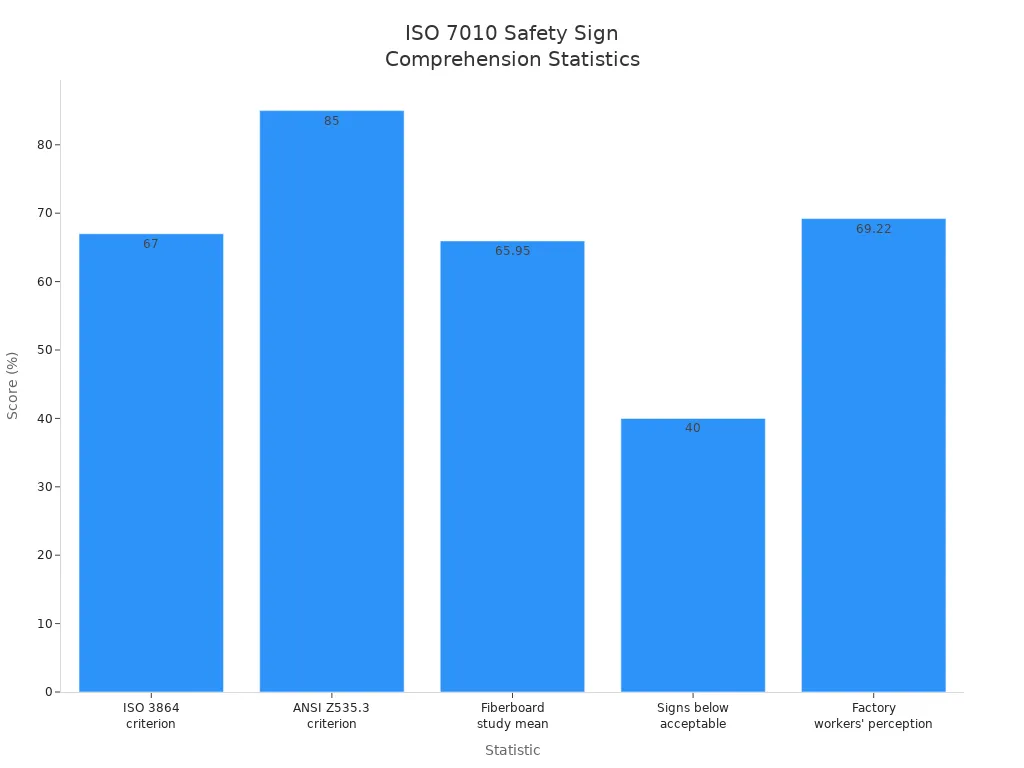
يجب على المنظمات التحقق من علامات المرور في كثير من الأحيان وتحديثها لمطابقة ISO 7010. إن استخدام هذه العلامات يساعد الجميع على اكتشاف المخاطر بسرعة. هذا يجعل مكان العمل أكثر أمانًا للجميع.
التعليمات
ما هو ISO 7010?
ISO 7010 هي قاعدة عالمية لعلامات السلامة. يخبرنا ما هي الألوان, الأشكال, ورموز للاستخدام. هذا يساعد الجميع على فهم رسائل السلامة بسرعة وسهولة.
لماذا يجب أن تستخدم أماكن العمل ISO 7010 علامات?
تستخدم أماكن العمل ISO 7010 علامات لوقف الالتباس والحوادث. هذه العلامات تساعد العمال على اكتشاف المخاطر والأماكن الآمنة على الفور. يمكن للناس فهمهم حتى لو يتحدثون لغات مختلفة.
كم مرة يجب فحص علامات السلامة أو استبدالها?
تحتاج المنظمات إلى التحقق من علامات السلامة في كثير من الأحيان. إذا تم كسر علامة, تلاشى, أو مفقود, يجب تغييره على الفور. تساعد الشيكات العادية في الحفاظ على واضحة الرسائل واتبع القواعد.
يمكن ISO 7010 يتم تخصيص العلامات لمخاطر محددة?
نعم, ISO 7010 يتيح لك تغيير علامات المخاطر الخاصة. ولكن يجب أن تحتفظ بالألوان المناسبة, الأشكال, والرموز. هذا يتأكد من أن الجميع يعرفون ما تعنيه العلامة دون خلطه.



